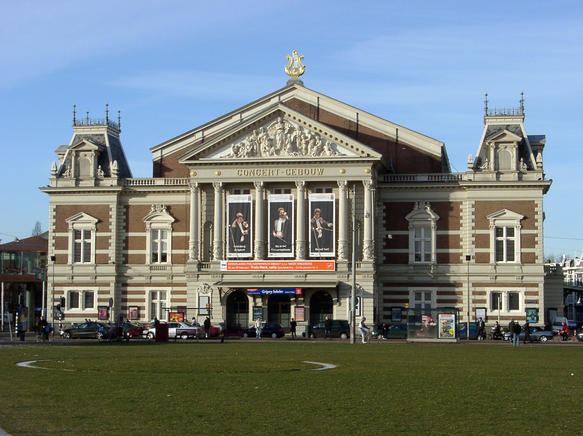Status Complete Architectural style Neoclassical Town or city Amsterdam Opened 11 April 1888 Province North Holland | Type Concert hall Location Museumplein Country Netherlands Phone +31 900 6718345 | |
 | ||
Address Concertgebouwplein 10, 1071 LN Amsterdam, Netherlands Architects Adolf Leonard van Gendt, Pi de Bruijn Profiles | ||
Beethoven symphony no 7 royal concertgebouw orchestra iv n fischer
The Royal Concertgebouw (Dutch: Koninklijk Concertgebouw, [ˌkoːnɪnklək kɔnˈsɛrt.xəˌbʌu̯]) is a concert hall in Amsterdam, Netherlands. The Dutch term "concertgebouw" literally translates into English as "concert building". On 11 April 2013, on occasion of the building's 125th anniversary, Queen Beatrix bestowed the Royal Title "Koninklijk" upon the building, as she did previously (in 1988) to the Royal Concertgebouw Orchestra. Because of its highly regarded acoustics, the Concertgebouw is considered one of the finest concert halls in the world, along with places such as Boston's Symphony Hall and the Musikverein in Vienna.
Contents
- Beethoven symphony no 7 royal concertgebouw orchestra iv n fischer
- History
- Organ
- Names of composers in the Main Hall
- In popular culture
- References
History
The architect of the building was Adolf Leonard van Gendt, who was inspired by the Gewandhaus in Leipzig, built two years earlier (and destroyed in 1943).
Construction began in 1883 in a pasture that was then outside the city, in Nieuwer-Amstel, a municipality that in 1964 became Amstelveen. A total of 2,186 piles of length twelve to thirteen metres (40 to 43 ft) were sunk into the soil.
The hall opened on 11 April 1888 with an inaugural concert, in which an orchestra of 120 musicians and a chorus of 500 singers participated, performing works of Wagner, Handel, Bach, and Beethoven. The resident orchestra of the Concertgebouw is the Royal Concertgebouw Orchestra (Koninklijk Concertgebouworkest), which gave its first concert in the hall on 3 November 1888, as the Concertgebouw Orchestra (Concertgebouworkest). For many decades the Netherlands Philharmonic Orchestra and the Radio Filharmonisch Orkest have also been regular performers in the Concertgebouw.
The Main Hall (Grote Zaal) seats 1,974, and is 44 metres (144 ft) long, 28 metres (92 ft) wide, and 17 metres (56 ft) high. Its reverberation time is 2.8 seconds without audience, 2.2 seconds with, making it ideal for the late Romantic repertoire such as Mahler. Though this characteristic makes it largely unsuited for amplified music, groups such as Led Zeppelin, The Who and Pink Floyd performed there in the 1960s. It hosts not only orchestral and operatic performances, but also jazz and world music.
A smaller, oval-shaped venue, the Recital Hall (Kleine Zaal), is located behind the Main Hall. The Recital Hall is 20 metres (66 ft) long and 15 metres (50 ft) wide. Its more intimate space is well-suited for chamber music and Lieder. The Recital Hall has 437 seats.
When the Concertgebouw was built, acoustics were something of a black art. As in shipbuilding, designers drew upon what had worked in the past without entirely understanding the underlying science. When the building was completed, the acoustics were not perfect, and a lot of effort went into fine-tuning the aural ambience. During later restorations, particular care has been taken not to alter the materials used for interior decoration with this in mind. In the 1980s, the hall embarked on extensive fund-raising for renovations after the hall was found to be slowly sinking into the ground. Pi de Bruijn was the architect for the contemporary annex to the original hall.
Today, some nine hundred concerts and other events per year take place in the Concertgebouw, for a public of over 700,000, making it one of the most-visited concert halls in the world.
As of February 2014, the managing director of the Concertgebouw is Simon Reinink and the artistic director is Anneke Hogenstijn.
Organ
The organ was built in 1890 by the organ builder Michael Maarschalkerweerd from Utrecht, and was renovated in the years 1990-1993 by the organ builder Flentrop. It has 60 registers on three divisions and pedal.
Names of composers in the Main Hall
In the Main Hall, the surnames of the following 46 composers are displayed on the balcony ledges and on the walls:
In popular culture
The Concertgebouw is mentioned, along with Madison Square Garden, the Hollywood Bowl, and the Rainbow Theatre, in the song "Rock Show" from the 1975 Wings album Venus and Mars.
Kris Debruyne, a Belgian singer, mentions the Concertgebouw in his song "Amsterdam".
